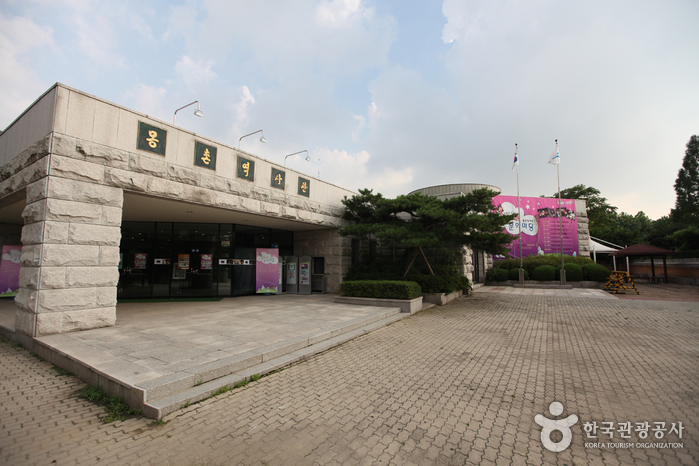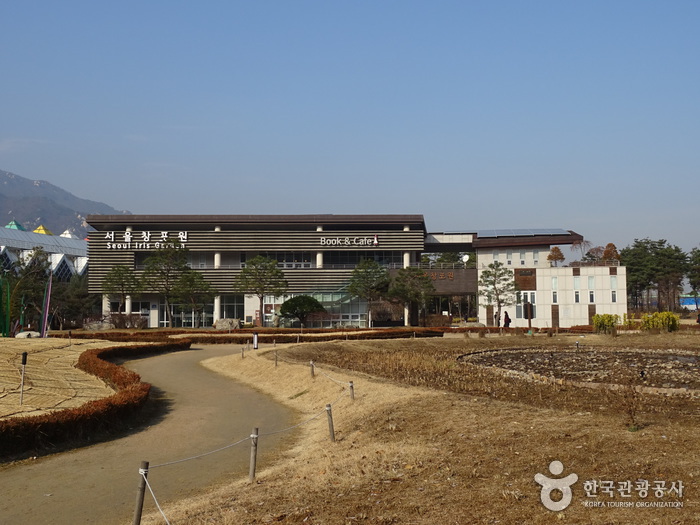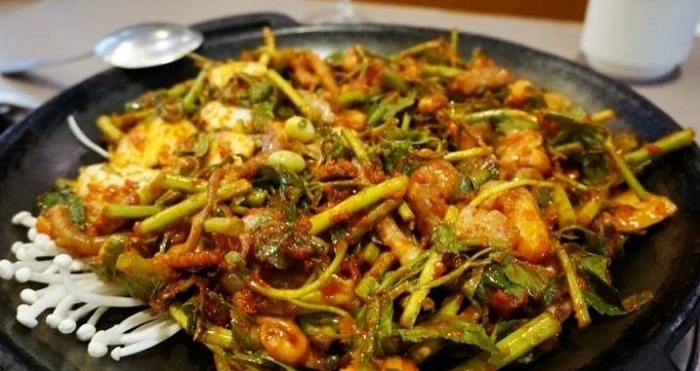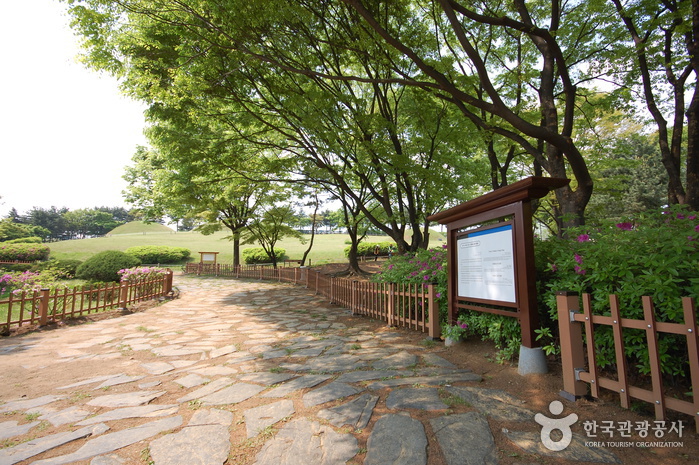Mongchon Museum of History (몽촌역사관)
14.5Km 2021-08-13
424, Olympic-ro, Songpa-gu, Seoul
+82-2-2152-5900
The Mongchon Museum of History, located within Olympic Park, displays artifacts from the excavations of Mongchontoseong Fortress, such as earthen fortifications as well as other artifacts of the Baekje Kingdom period, offering a glimpse into Baekje culture. A model of a Baekje dugout hut site reveals ancient dwelling patterns. Also, the facility displays a perfectly preserved model of ancient houses and tombs, giving visitors the feel of traveling back to prehistoric ages.
Seoul Baekje Museum (한성백제박물관)
14.5Km 2021-03-11
71, Wiryeseong-daero, Songpa-gu, Seoul
+82-2-2152-5800
Opened on April 30, 2012, Seoul Baekje Museum was founded by the Seoul Metropolitan Government in order to preserve artifacts related to Seoul's 2,000-year-old history and to shed light on Seoul's cultural identity. The museum is located inside Olympic Park, overlooking Mongchontoseong Fortress.
Seoul Iris Garden (서울창포원)
14.5Km 2020-08-24
916, Madeul-ro, Dobong-gu, Seoul
+82-2-954-0031
Seoul Iris Garden is located between Dobongsan and Suraksan mountains in northern Seoul. The garden, measuring 52,417 ㎡, boasts a wide array of irises and other plants in 12 different themed zones including Iris Garden, Medicinal Plant Garden, and Wetland Park.
At the Iris Garden, 300,000 irises in 130 species are on display on a plot of land measuring 15,000 ㎡. Species include yellow iris, iris setosa, iris pallasii, and iris domestica, each boasting its own brilliant colors and delicate shape. The Medicinal Plant Garden is home to 130,000 plants in 70 different species of medicinal plants, allowing visitors to view the largest selection of medicinal herbs in the country. Wetland Park presents 70,000 wetland plants and houses an observatory deck from which visitors may view and learn about the diverse aquatic plants.
Cheoni Observatory within the garden provides visitors with a place take to in the beautiful scenery from above. The nearby forest lounge is a rest area for visitors as well as a center of operations for the park’s ecological education programs. Irises are in bloom from May to June of every year, but are even a sight to behold during the rest of the warmer months, given the delicate shape of their leaves.
Philkyungjae (필경재)
14.5Km 2024-03-07
205, Gwangpyeong-ro, Gangnam-gu, Seoul
+82-2-445-2115
Philkyungjae is a restaurant serving traditional Korean cuisine served in the royal courts of Joseon. Its course menu includes jeonbokjuk (abalone porridge), bossam (napa wraps with pork), sogogi japchae (beef japchae), tteokgalbi (grilled galbi patties), and hanu yukhoe (Korean beef tartare). There are five courses on offer. All five courses are available during lunch, while dinnertime limits the selection to three. The restaurant is housed in a traditional house and garden dating back to the Joseon Dynasty (1392-1910), so guests can enjoy the architectural beauty of Korea with Korean flavors. Reservations can be placed through telephone.
Cheonghaejin(청해진)
14.6Km 2021-04-13
33 Seongnae-ro 6-gil Gangdong-gu Seoul
+82-2-484-1551
It is a 100-year-old store that has been loved by customers for a long time while maintaining its reputation for over 30 years. This Korean dishes restaurant is located in Gangdong-gu, Seoul. The representative menu is seafood pancake.
Parkchulwoong Optique [Tax Refund Shop] (박철웅안경원)
14.6Km 2024-06-27
1F, 235, Siheung-daero, Geumcheon-gu, Seoul
-
JDX - Gangdong Station Branch [Tax Refund Shop] (강동역점JDX)
14.6Km 2024-04-22
1084, Cheonho-daero, Gangdong-gu, Seoul
-
Olive Young - Siheung Sageori Branch [Tax Refund Shop] (올리브영 시흥사거리)
14.7Km 2024-04-22
228, Siheung-daero, Geumcheon-gu, Seoul
-
Seoul Bangidong Ancient Tombs (서울 방이동 고분군)
14.7Km 2022-12-29
219, Ogeum-ro, Songpa-gu, Seoul
+82-2-2147-2800
The ancient tombs in Bangi-dong were discovered during the land readjustment project of Jamsil-jigu District in 1975. A total of eight ancient tombs were excavated until 1976, and the site was restored into a park in 1983. The Bangi-dong area was originally a low line of hills with an altitude of 30-50 meters above sea level, but it has been made into flatland for urban development purposes. Tomb numbers 1 to 6 lie on the same hill, while tomb no. 7 and 8 are located on another hill a short distance away.
All eight tombs have circular burial mounds. The insides of the a tomb feature a square or rectangular-shaped burial chamber with earthen ground and stone walls, and a passage leading from the tomb entrance to the chamber. However, details of the burial chambers vary by tomb. Most of the tombs had been robbed before the investigation, but a few relics such as plates and pots have been excavated. At the time of excavation, the relics were presumed to have come from the Baekje dynasty (18 BC-660 AD), but it is now estimated that they date back to the Unified Silla Period (676-935 AD).
Olive Young - Eunhaengnamu Sageori Branch [Tax Refund Shop] (올리브영 은행나무사거리)
14.7Km 2024-04-18
705, Geumha-ro, Geumcheon-gu, Seoul
-




![JDX - Gangdong Station Branch [Tax Refund Shop] (강동역점JDX)](http://tong.visitkorea.or.kr/cms/resource/91/2878891_image2_1.jpg)
![Olive Young - Siheung Sageori Branch [Tax Refund Shop] (올리브영 시흥사거리)](http://tong.visitkorea.or.kr/cms/resource/48/2880448_image2_1.jpg)

![Olive Young - Eunhaengnamu Sageori Branch [Tax Refund Shop] (올리브영 은행나무사거리)](http://tong.visitkorea.or.kr/cms/resource/86/2888486_image2_1.jpg)
 English
English
 한국어
한국어 日本語
日本語 中文(简体)
中文(简体) Deutsch
Deutsch Français
Français Español
Español Русский
Русский